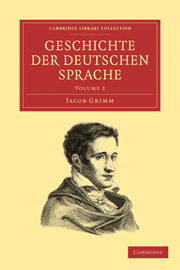Book contents
- Frontmatter
- XXI HESSEN UND BATAVEN
- XXII HERMUNDUREN
- XXIII DIE NIEDERDEUTSCHEN
- XXIV FRIESEN UND CHAUKEN
- XXV LANGOBARDEN UND BURGUNDEN
- XXVI DIE UBRIGEN OSTSTÄMME
- XXVII SCANDINAVIEN
- XXVIII DIE EDDA
- XXIX GERMANEN UND DEUTSCHE
- XXX RÜCKBLICK
- XXXI DEUTSCHE DIALECTE
- XXXII DER ABLAUT
- XXXIII DIE REDUPLICATION
- XXXIV SCHWACHE VERBA
- XXXV VERSCHOBNES PRAETERITUM
- XXXVI DIE VOCALE DER DECLINATION
- XXXVII DER INSTRUMENTALIS
- XXXVIII SCHWACHE NOMINA
- XXXIX DER DUALIS
- XL RECHT UND LINK
- XLI MILCH UND FLEISCH
- XLII SCHLUSS
- Bemerkte druckfehler, lies
XXXIII - DIE REDUPLICATION
Published online by Cambridge University Press: 29 August 2010
- Frontmatter
- XXI HESSEN UND BATAVEN
- XXII HERMUNDUREN
- XXIII DIE NIEDERDEUTSCHEN
- XXIV FRIESEN UND CHAUKEN
- XXV LANGOBARDEN UND BURGUNDEN
- XXVI DIE UBRIGEN OSTSTÄMME
- XXVII SCANDINAVIEN
- XXVIII DIE EDDA
- XXIX GERMANEN UND DEUTSCHE
- XXX RÜCKBLICK
- XXXI DEUTSCHE DIALECTE
- XXXII DER ABLAUT
- XXXIII DIE REDUPLICATION
- XXXIV SCHWACHE VERBA
- XXXV VERSCHOBNES PRAETERITUM
- XXXVI DIE VOCALE DER DECLINATION
- XXXVII DER INSTRUMENTALIS
- XXXVIII SCHWACHE NOMINA
- XXXIX DER DUALIS
- XL RECHT UND LINK
- XLI MILCH UND FLEISCH
- XLII SCHLUSS
- Bemerkte druckfehler, lies
Summary
Wie der einfache vocal durch vortritt eines andern guniert oder diphthongiert wird und wie dann die wurzel ablautet haben wir gesehn; dem sprachgenius steht aber noch eine aushülfe zu gebot: er lässt den anlaut der wurzel selbst vortreten und sich doppeln. das wort wird gleichsam erst schwächer und zur hälfte angeschlagen, um dann nochmals desto voller und vernehmlicher zu erschallen.
Am nachdrücklichsten wirkt diese verdoppelung, wenn nicht das halbe, sondern ganze wort sich selbst vorangeht z. b. im ahd. sôsô (goth. svasvê), dohdoh, lat. quamquam u. s. w. unsere sprache liebt es, nach dem grundsatz der ersten und zweiten reihe des ablauts, dem Alaut einen I oder Ulaut vorher zu schicken, sei es in losen oder zusammengefügten wörtern, z. b. blicken blacken Helbl. 3, 317; timpen tampen Tit. 190; enplipfes und enplapfes Helbl. 3, 364; wigen wagen; gugen gagen; glunken glanken; singsang; wirrwarr; noch mehrere sind gramm. 1, 562 gesammelt, aus welchen allen man einen schluss für den höheren rang des A ziehen könnte, insofern die laute der vorangestellten wörter oder silben nur eine zweite, schwächere potenz zu enthalten scheinen.
Solche volle wiederholungen sind jedoch zu lebhaft, um anders als sparsam in der rede verwandt zu werden, und ungeeignet einen wolthätigen hebel der flexion, der allenthalben auftreten muss, zu begründen. die sprache ist ihrem innersten wesen nach haushältig und zieht was sie mit geringen mitteln erreichen kann jederzeit grösserem aufwand vor.
- Type
- Chapter
- Information
- Geschichte der deutschen Sprache , pp. 863 - 876Publisher: Cambridge University PressPrint publication year: 2009First published in: 1848



